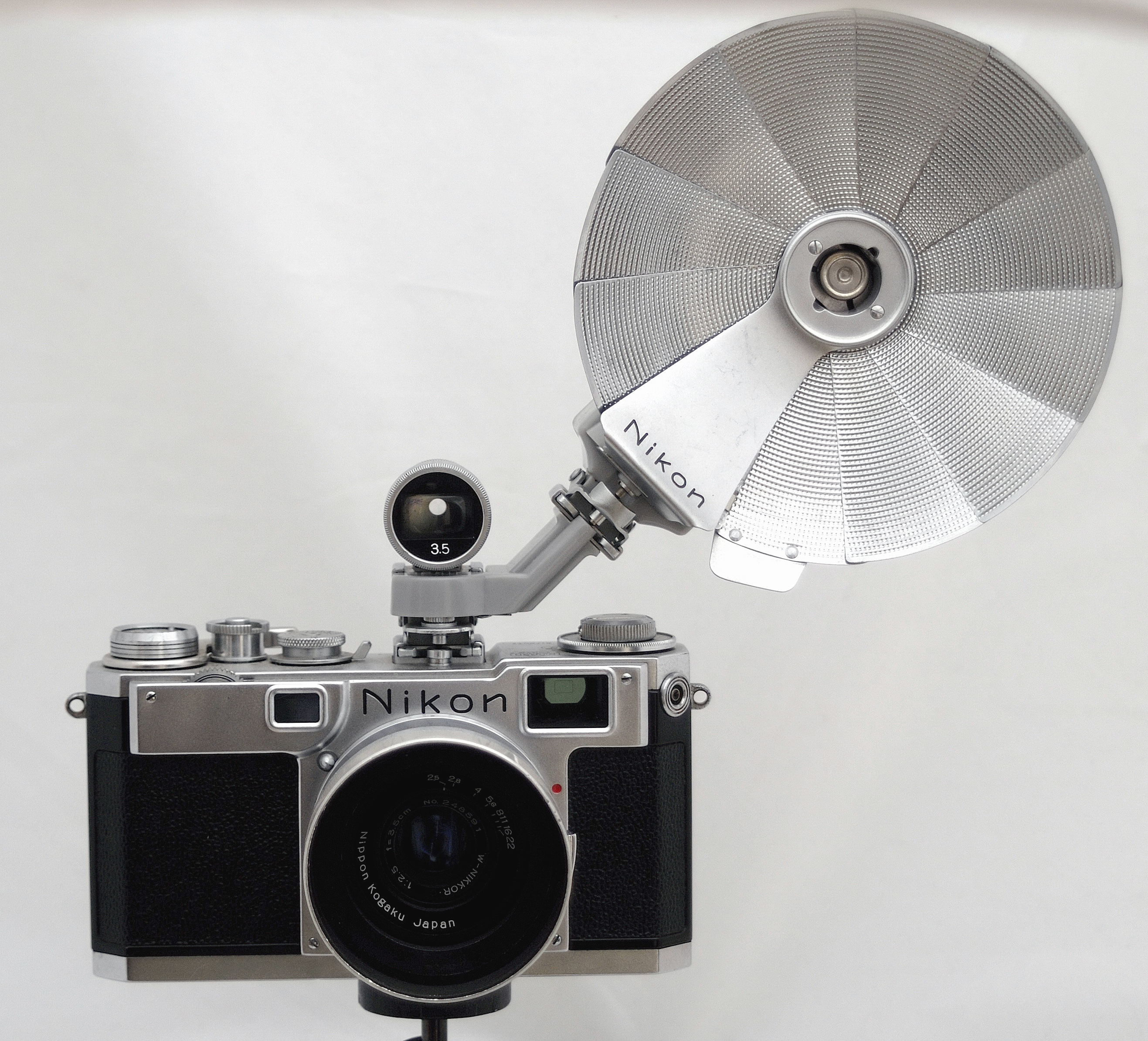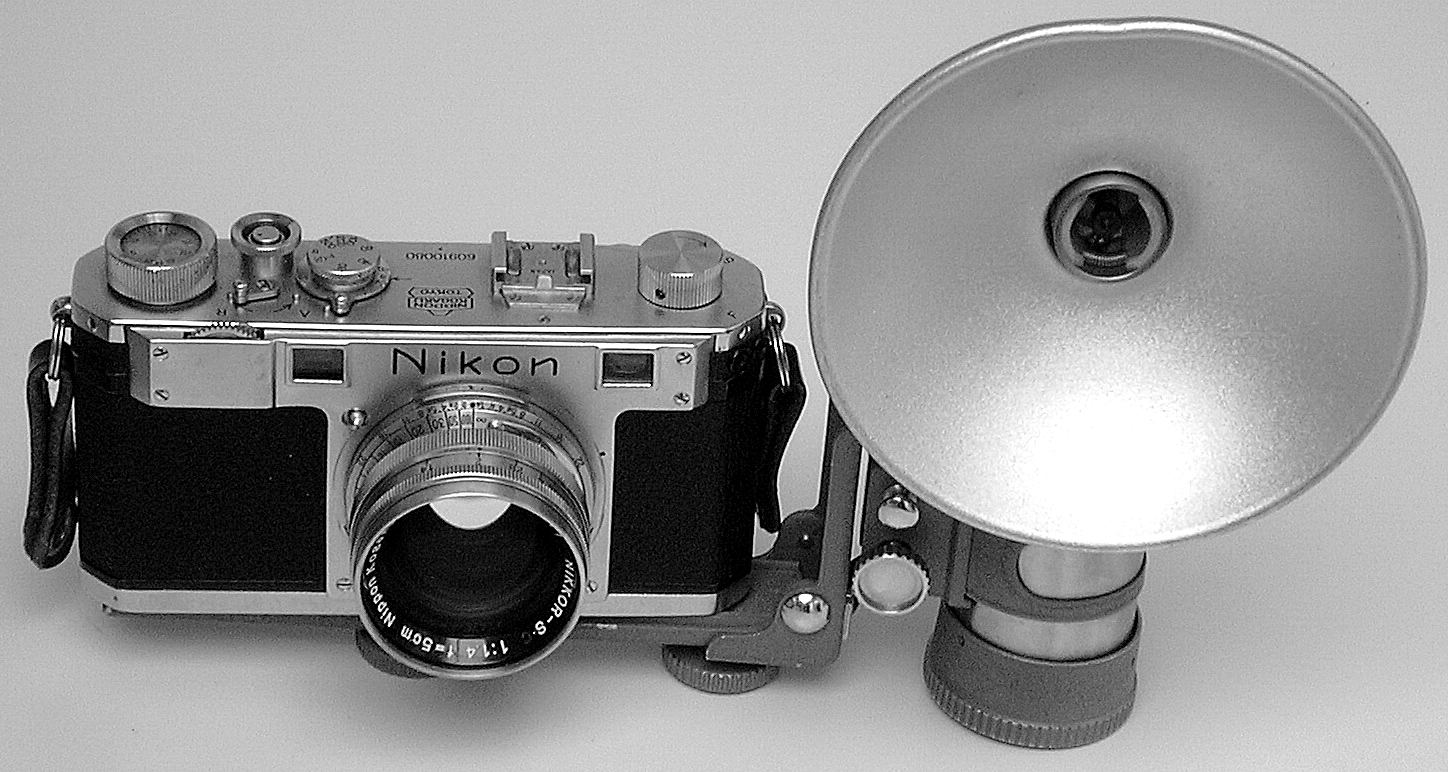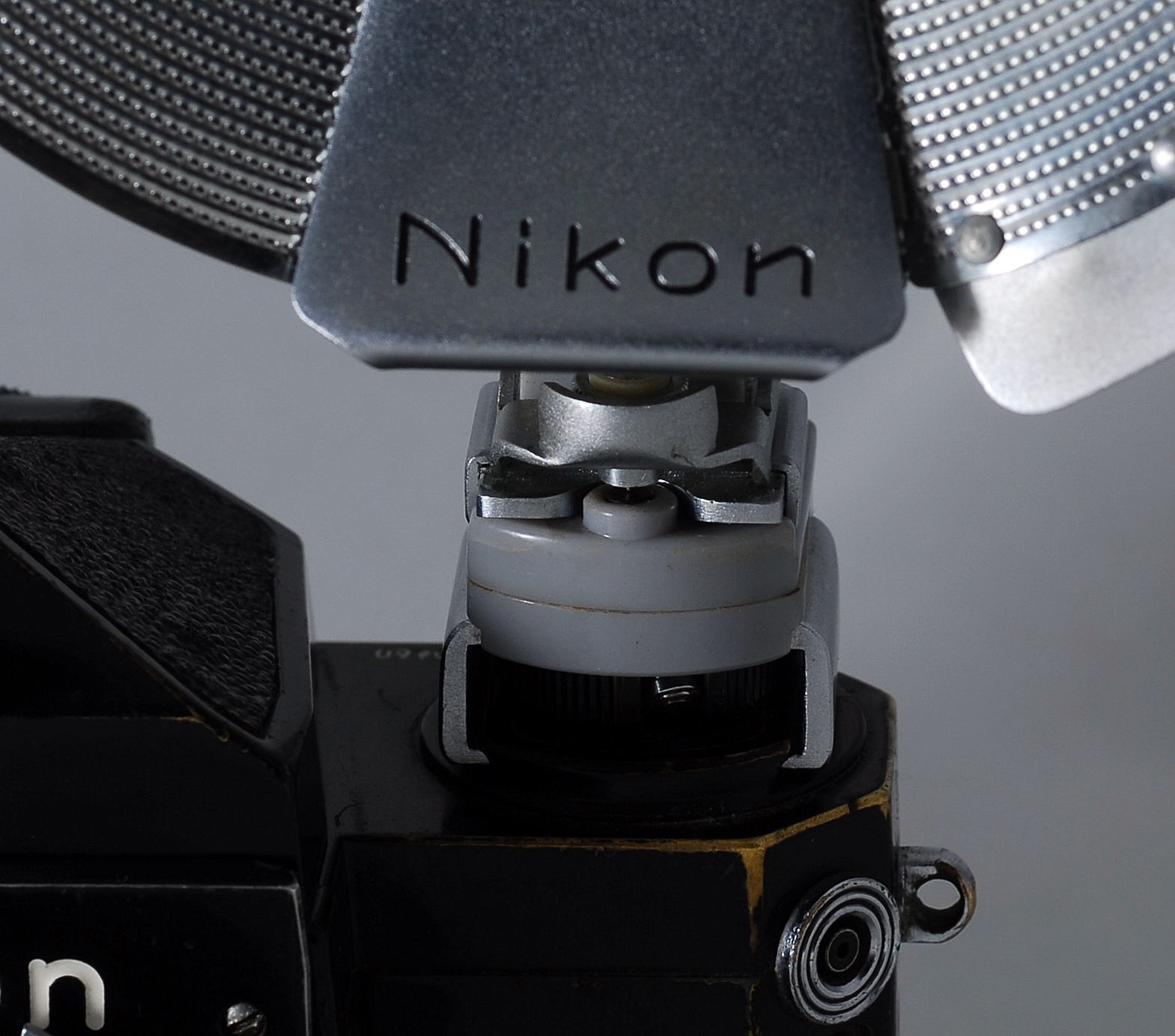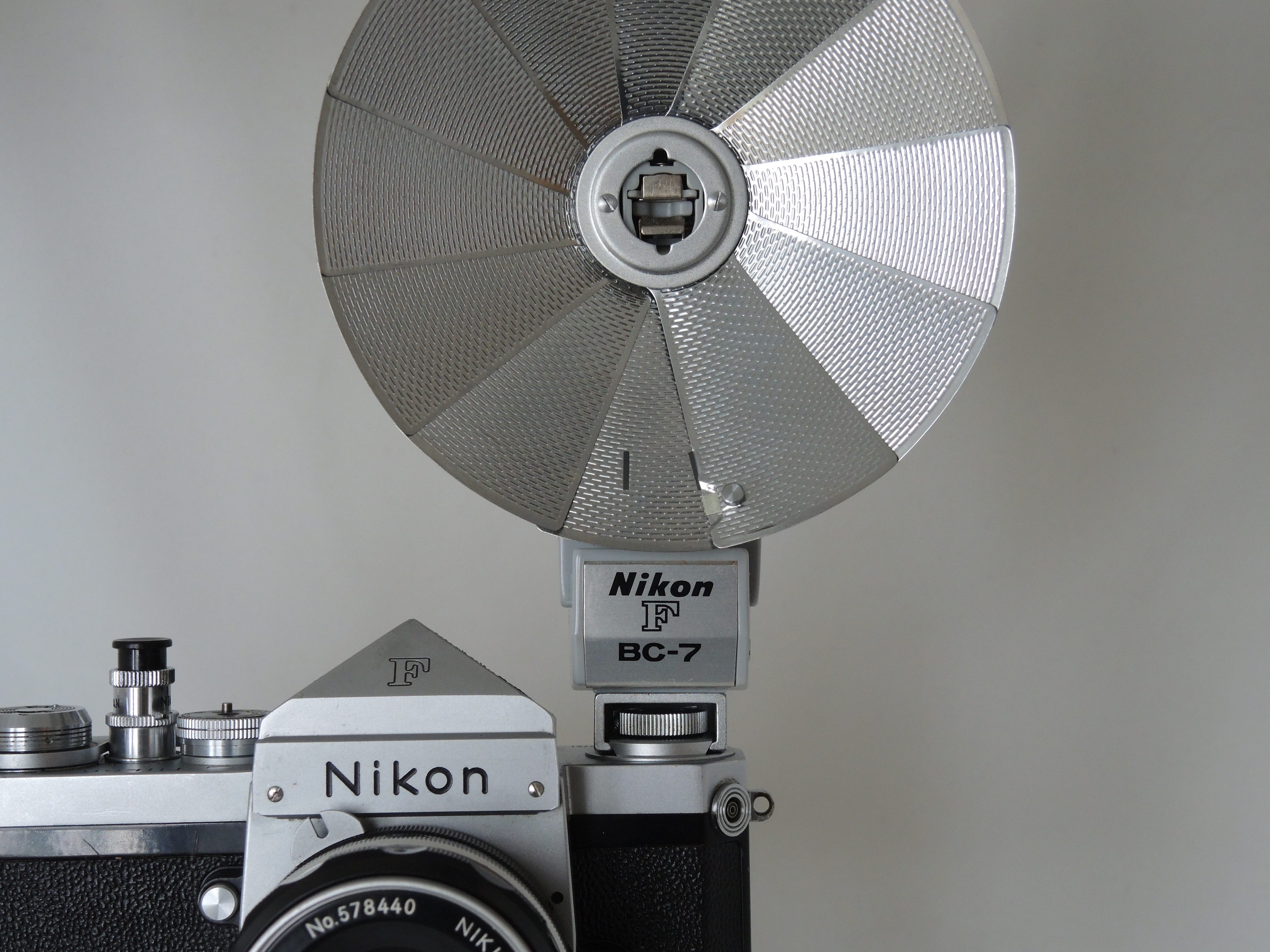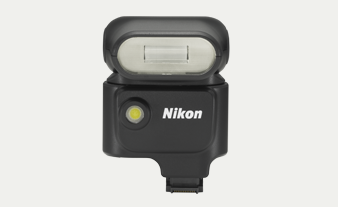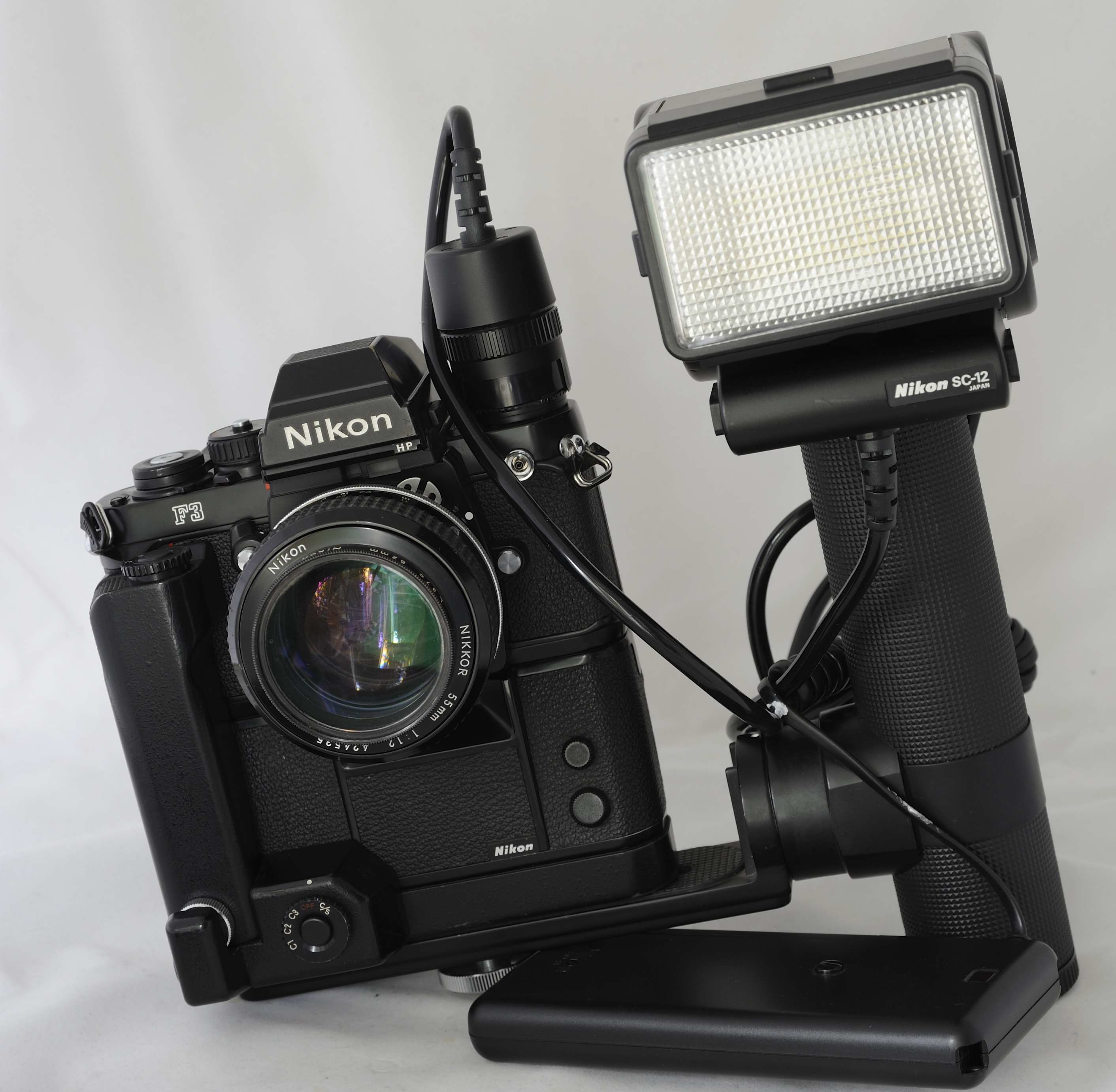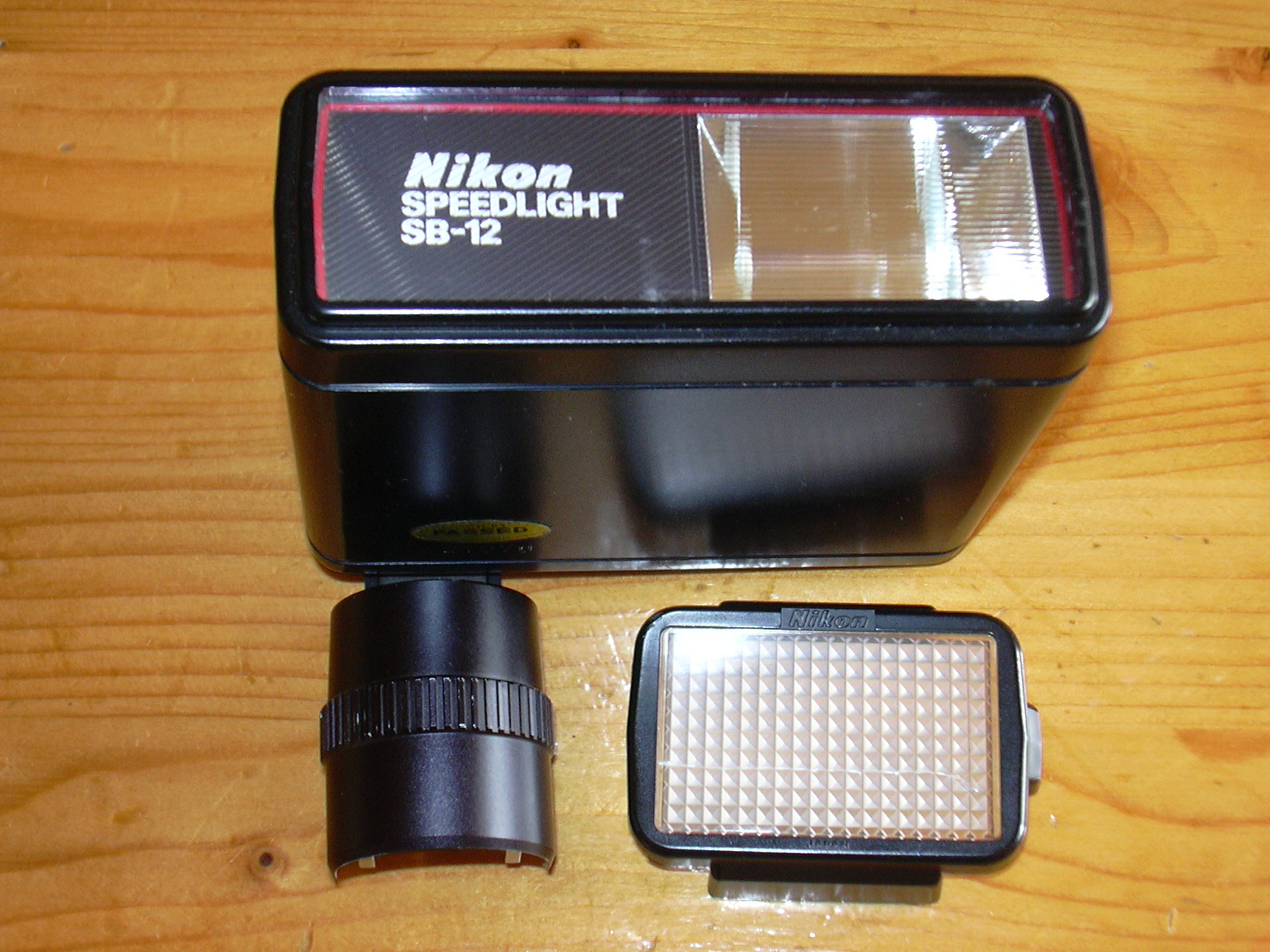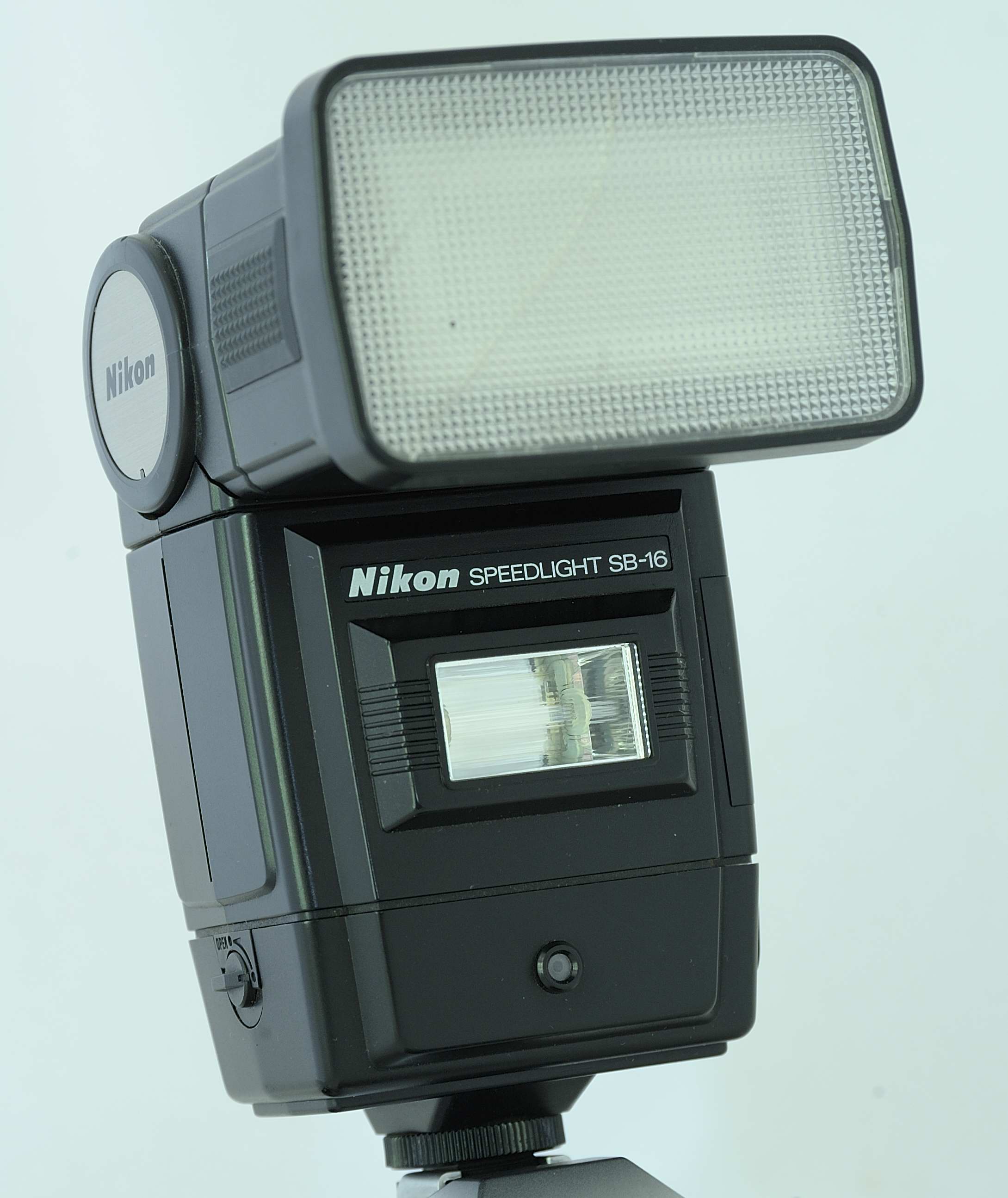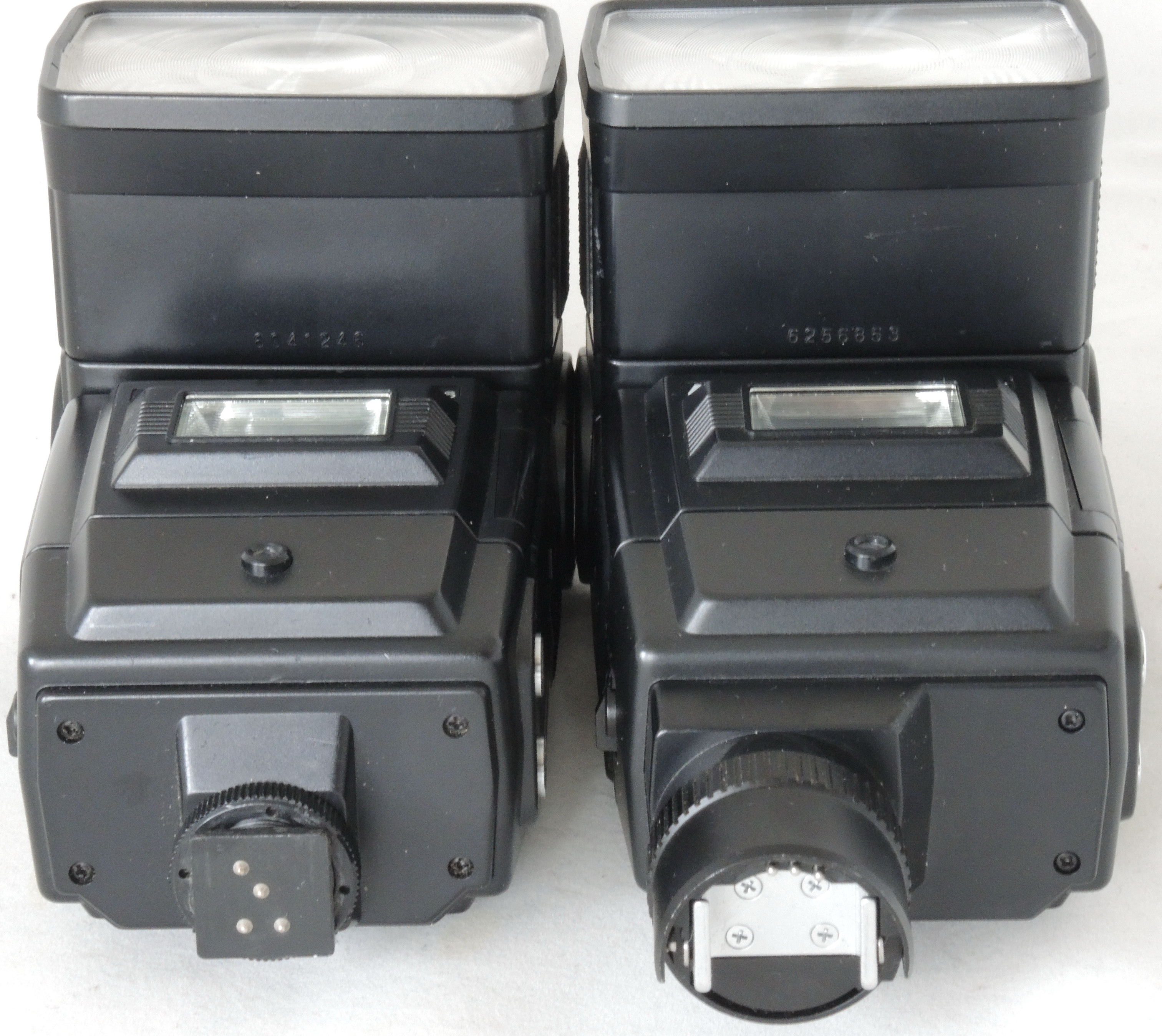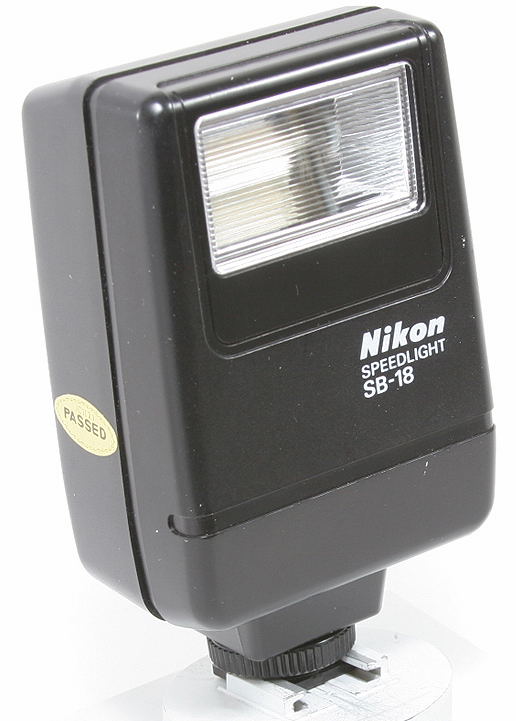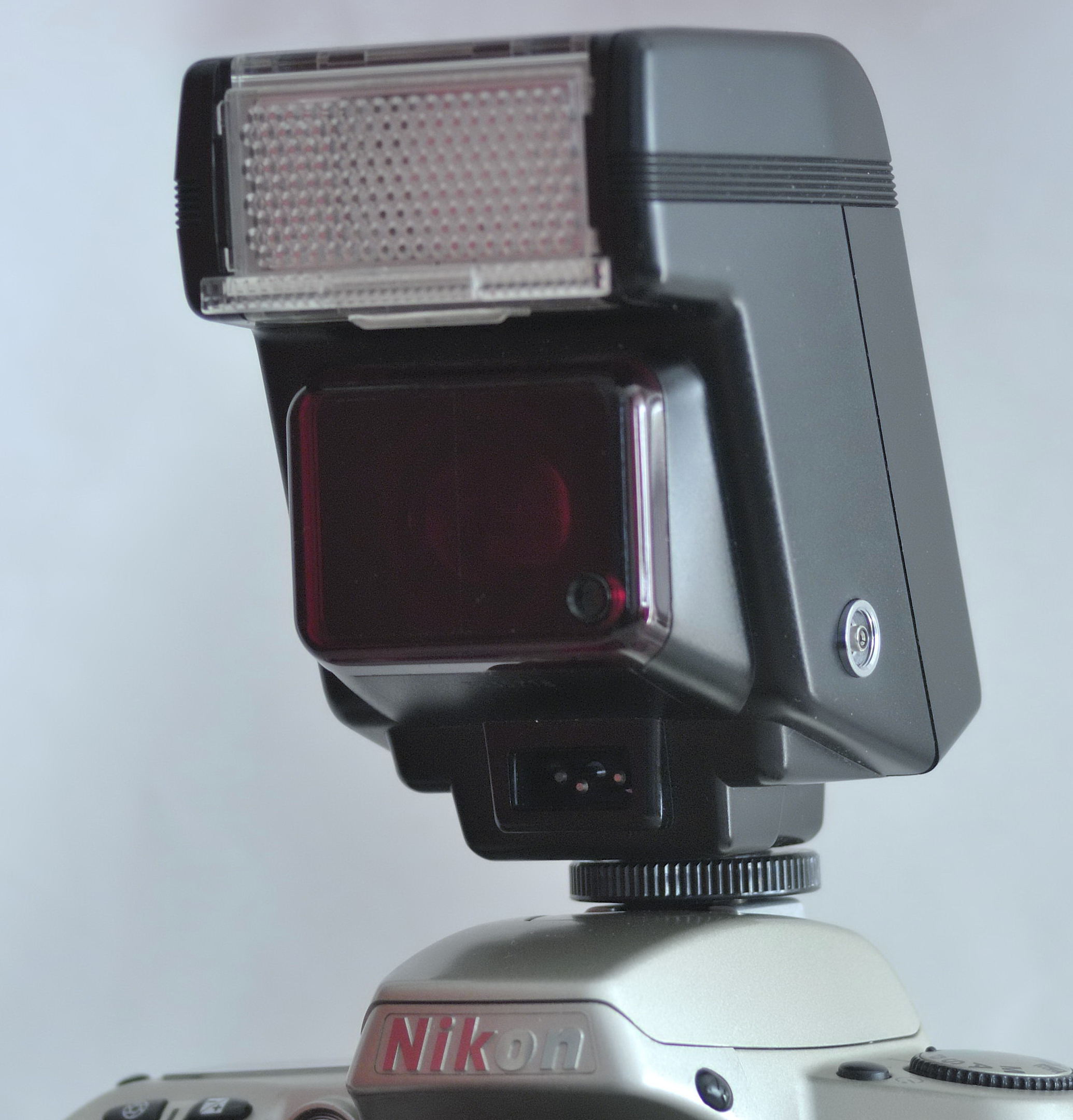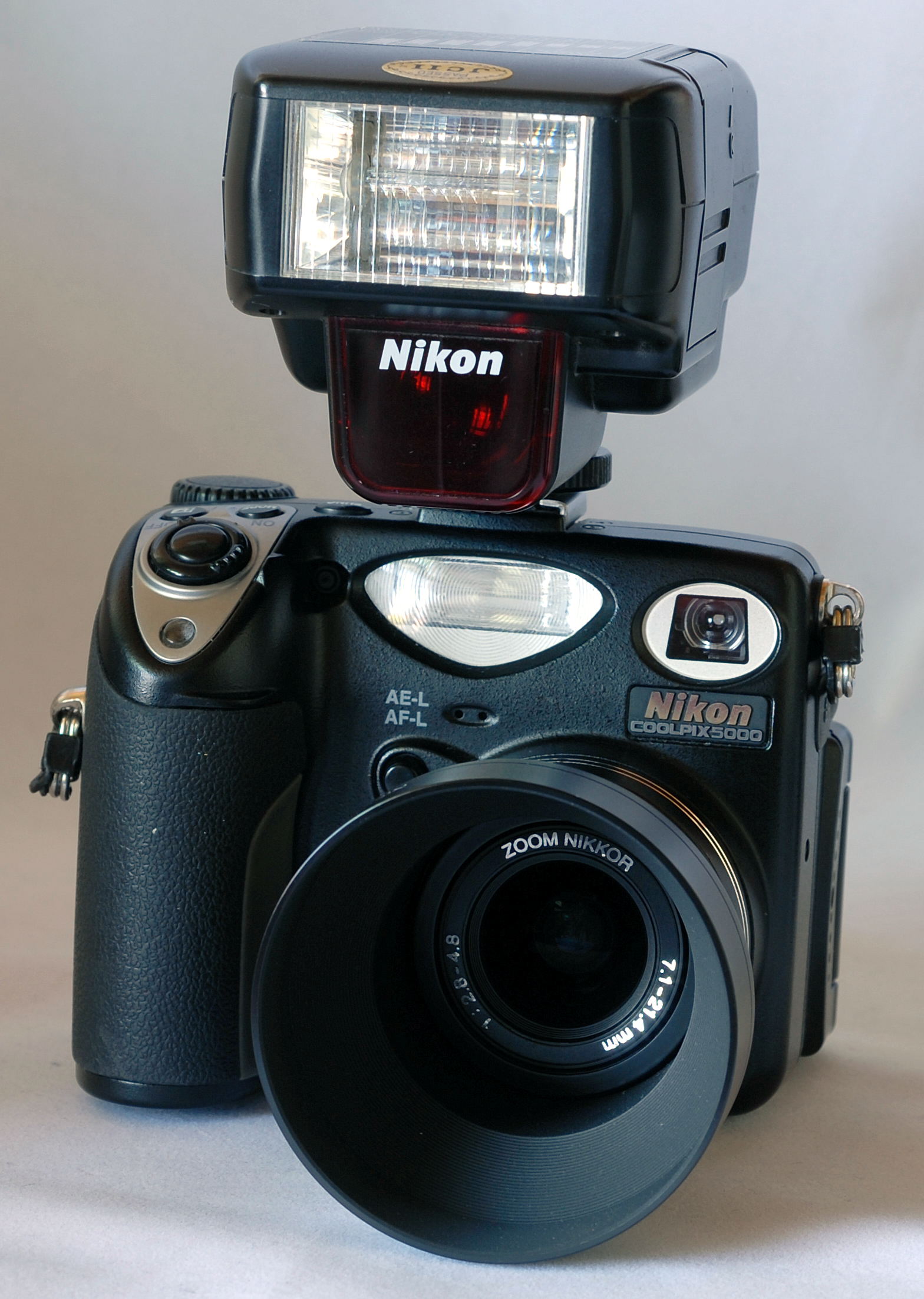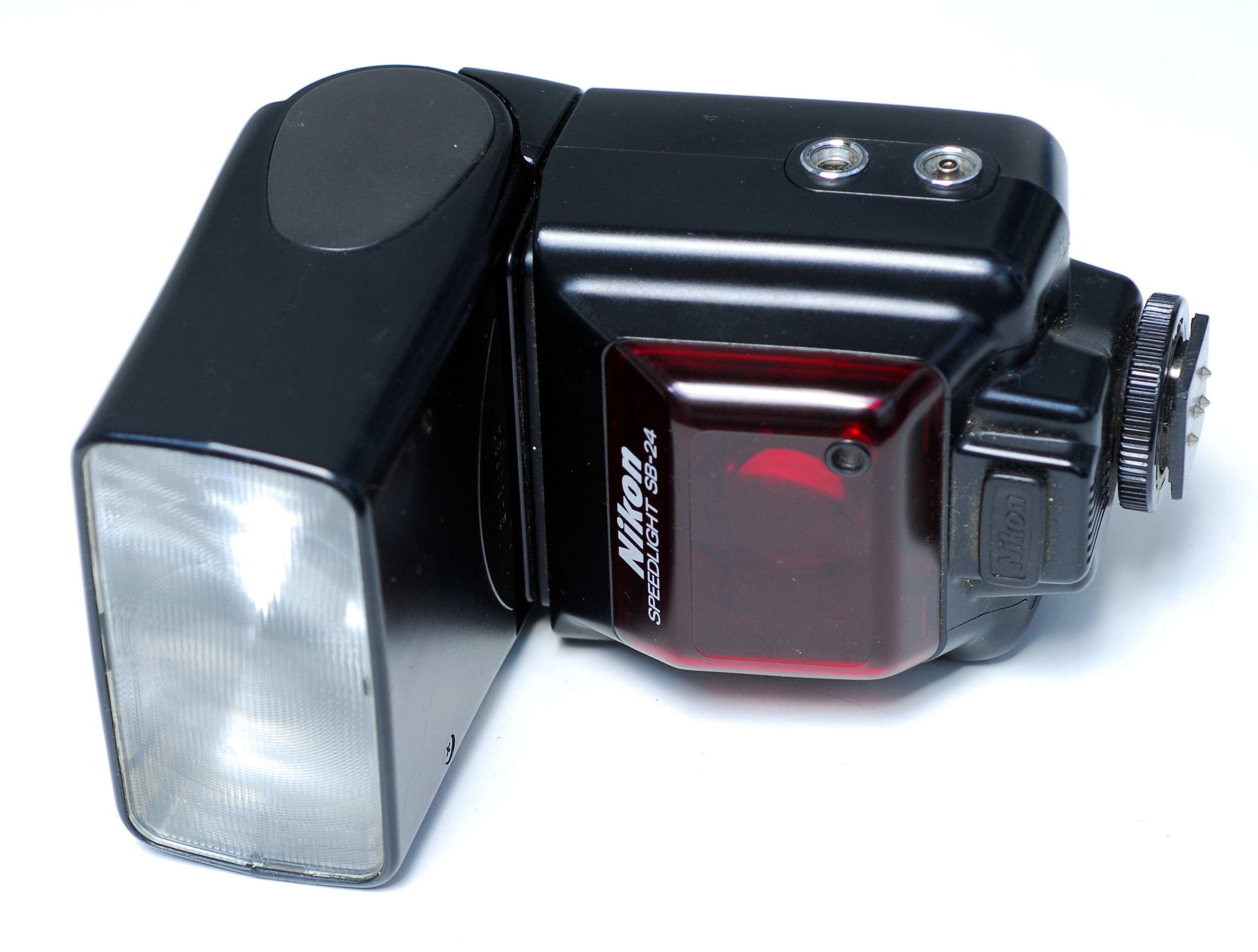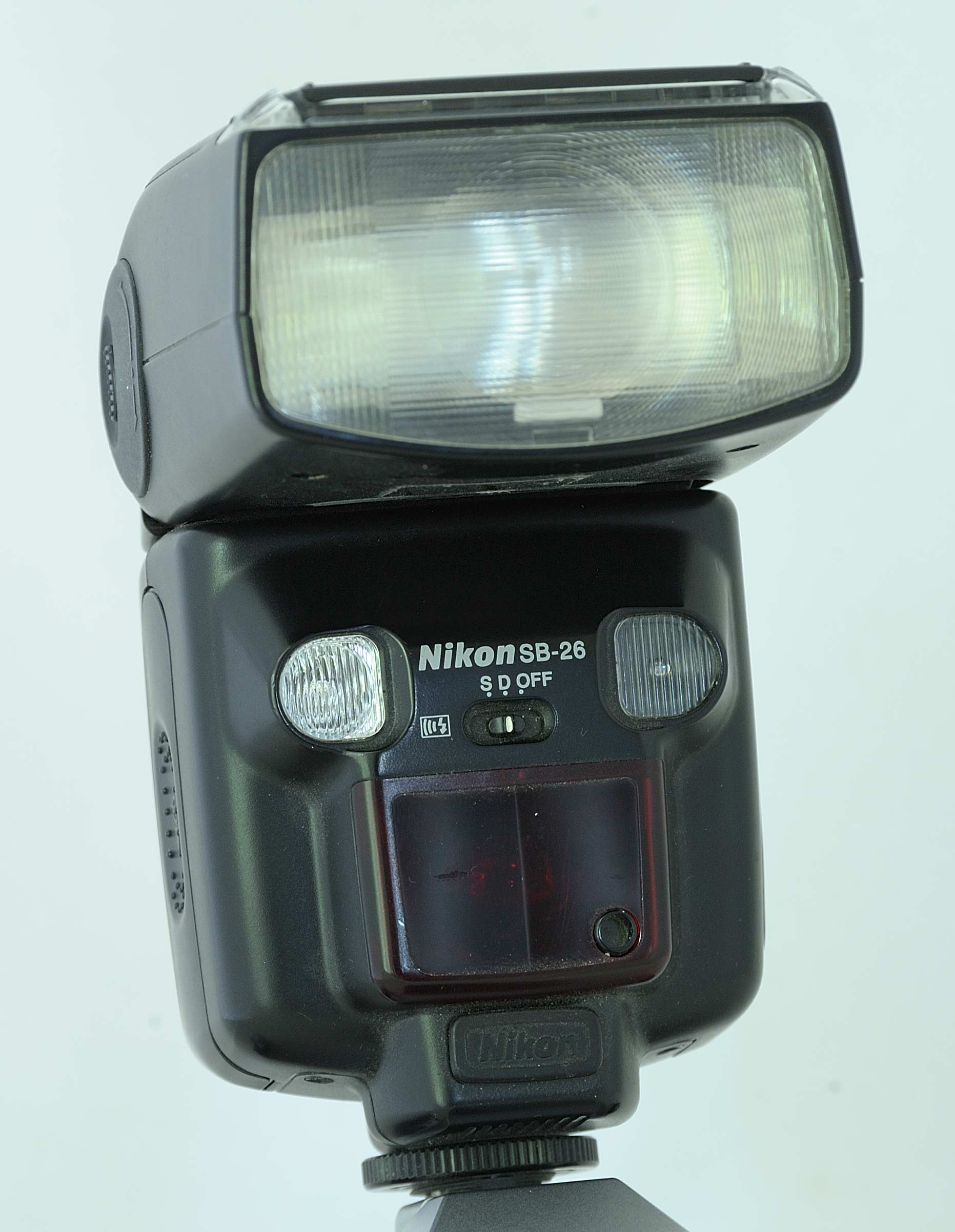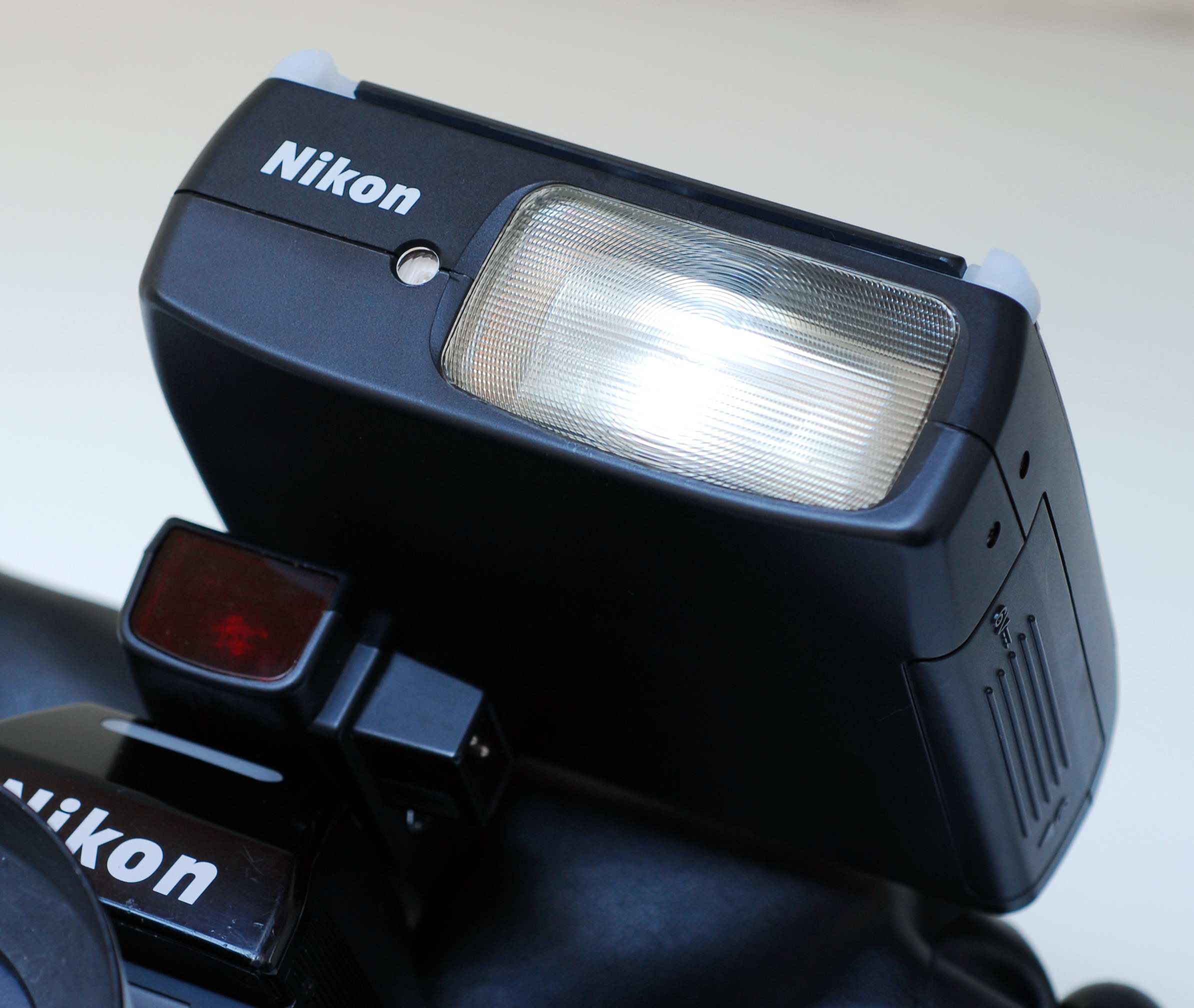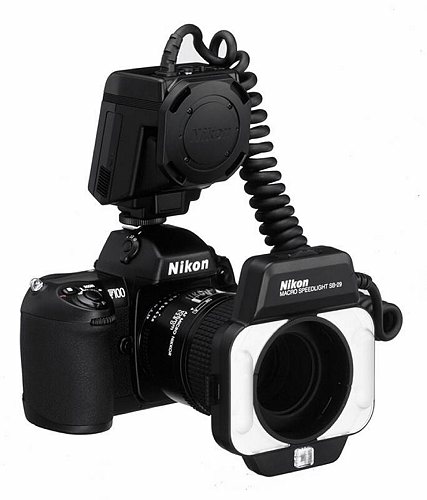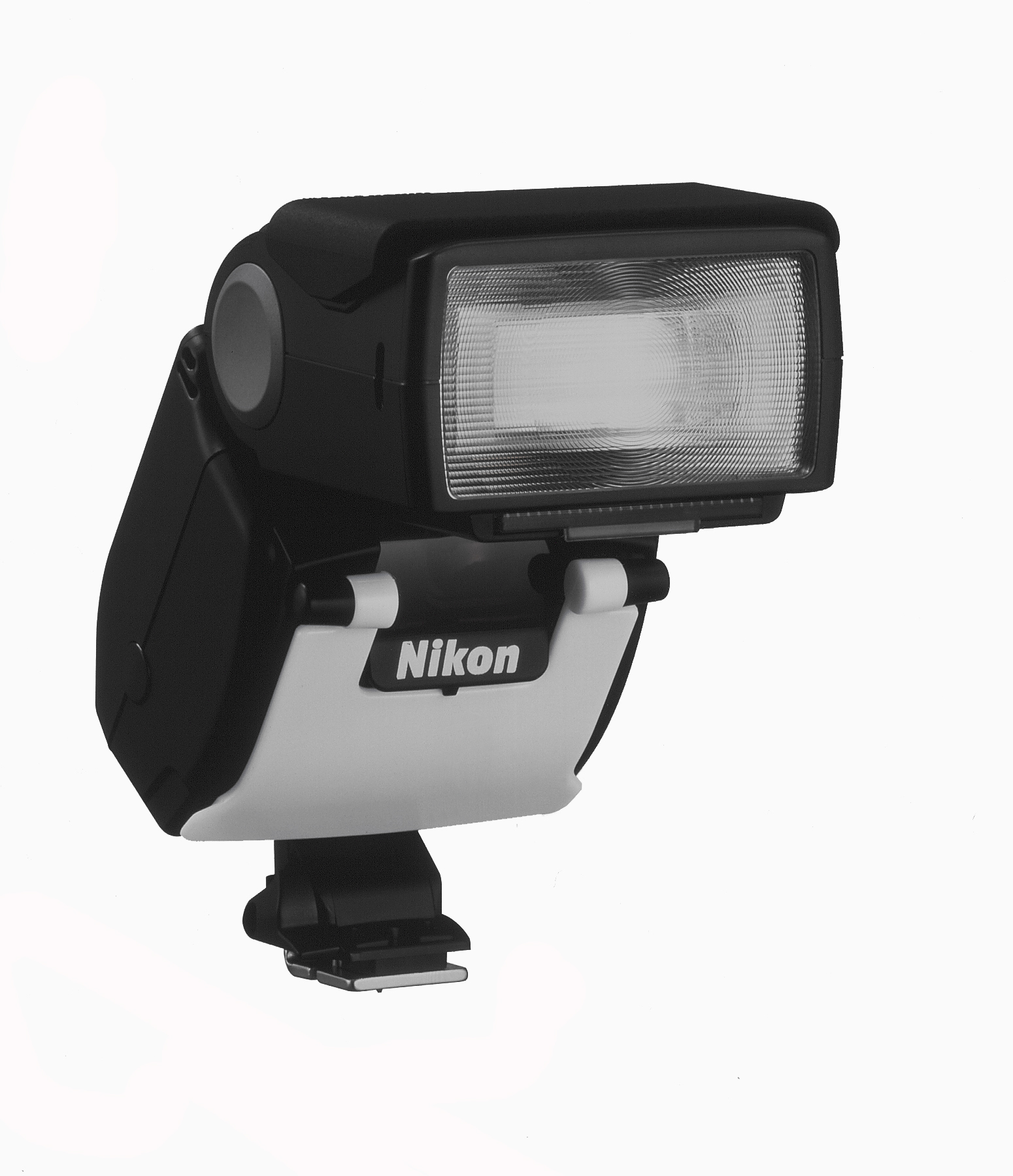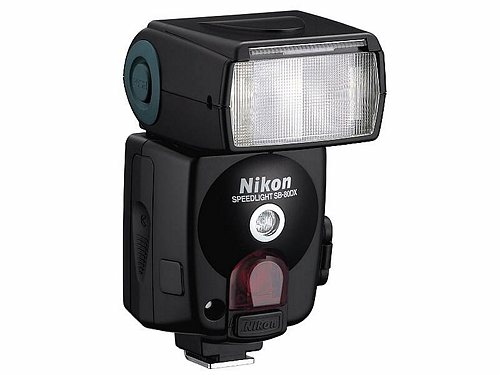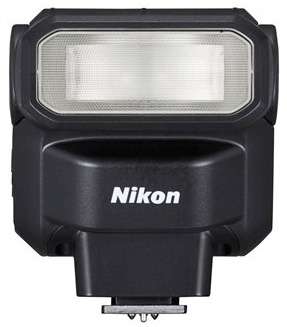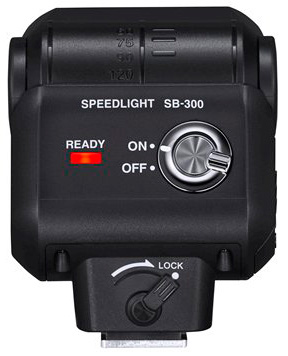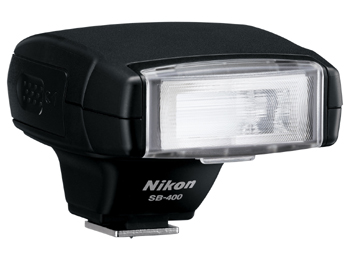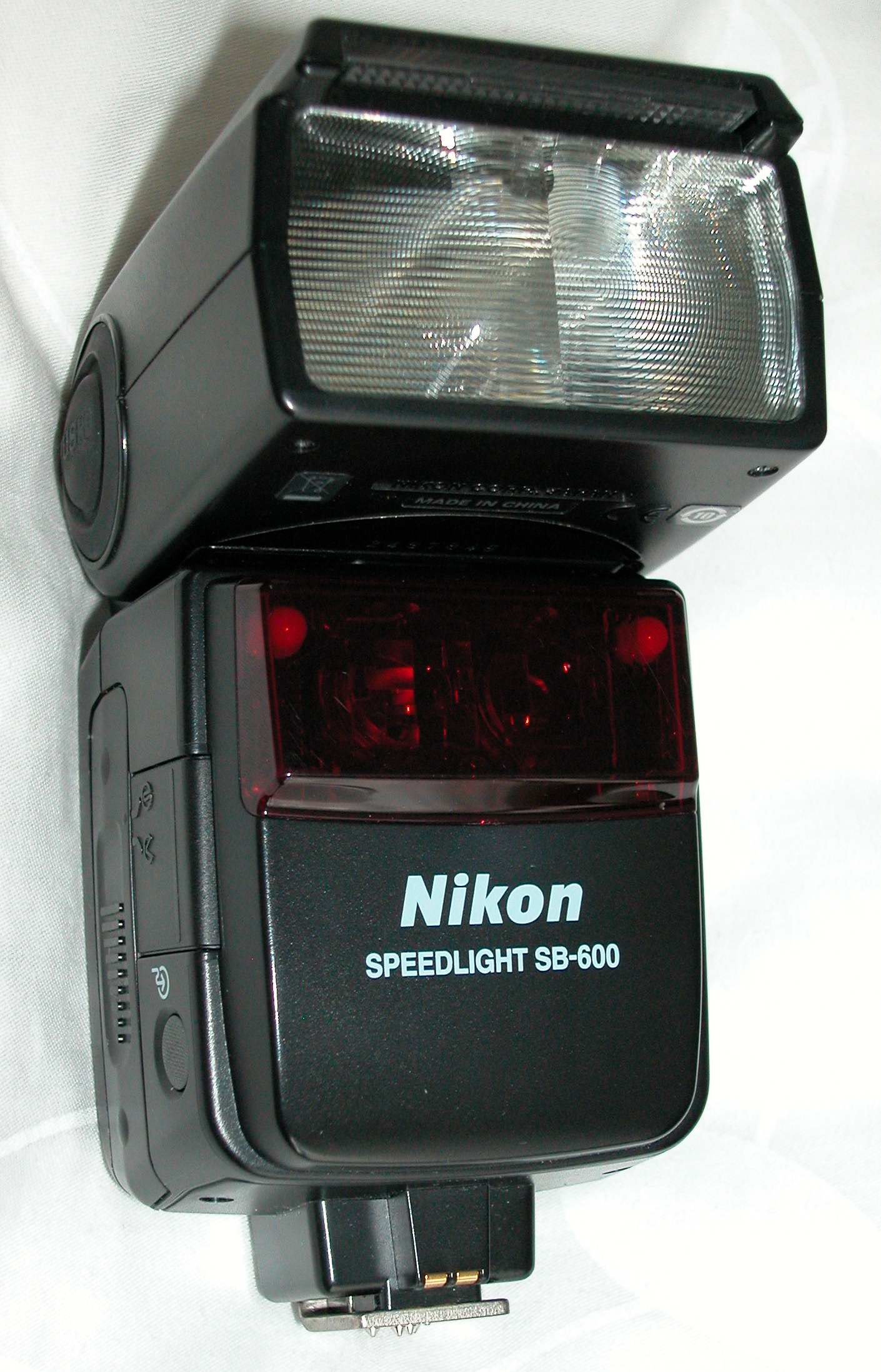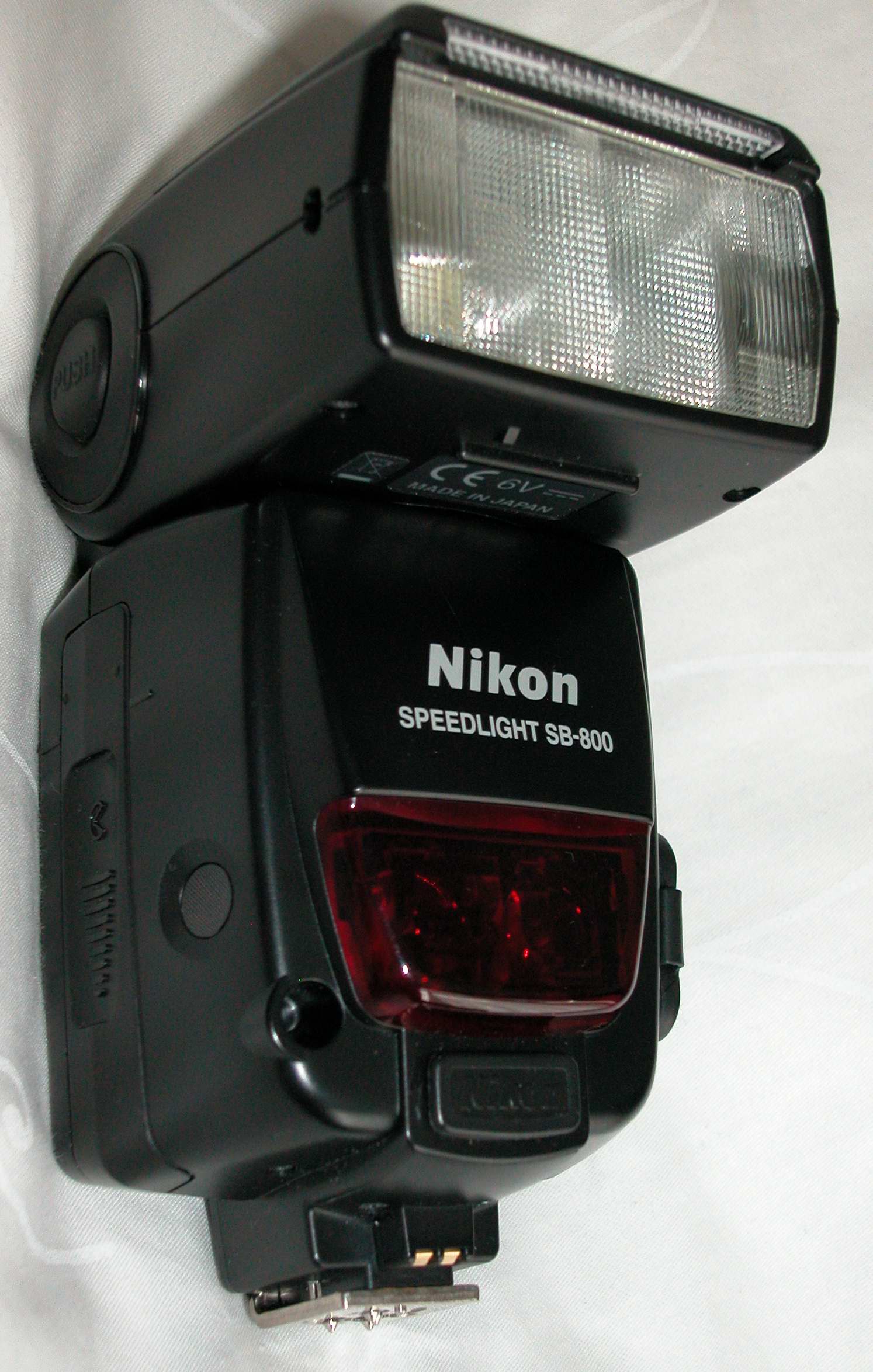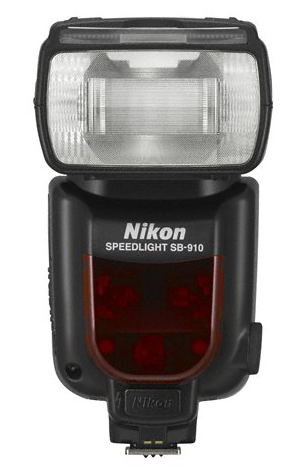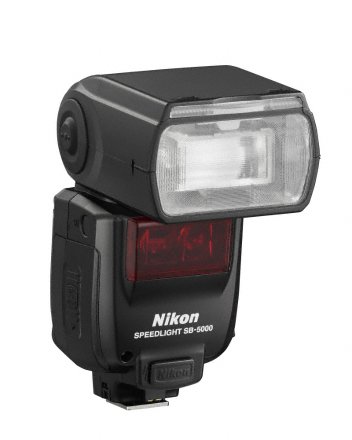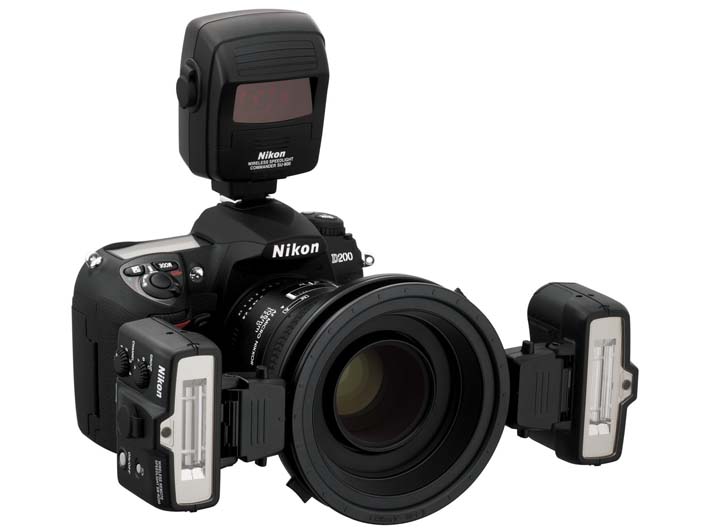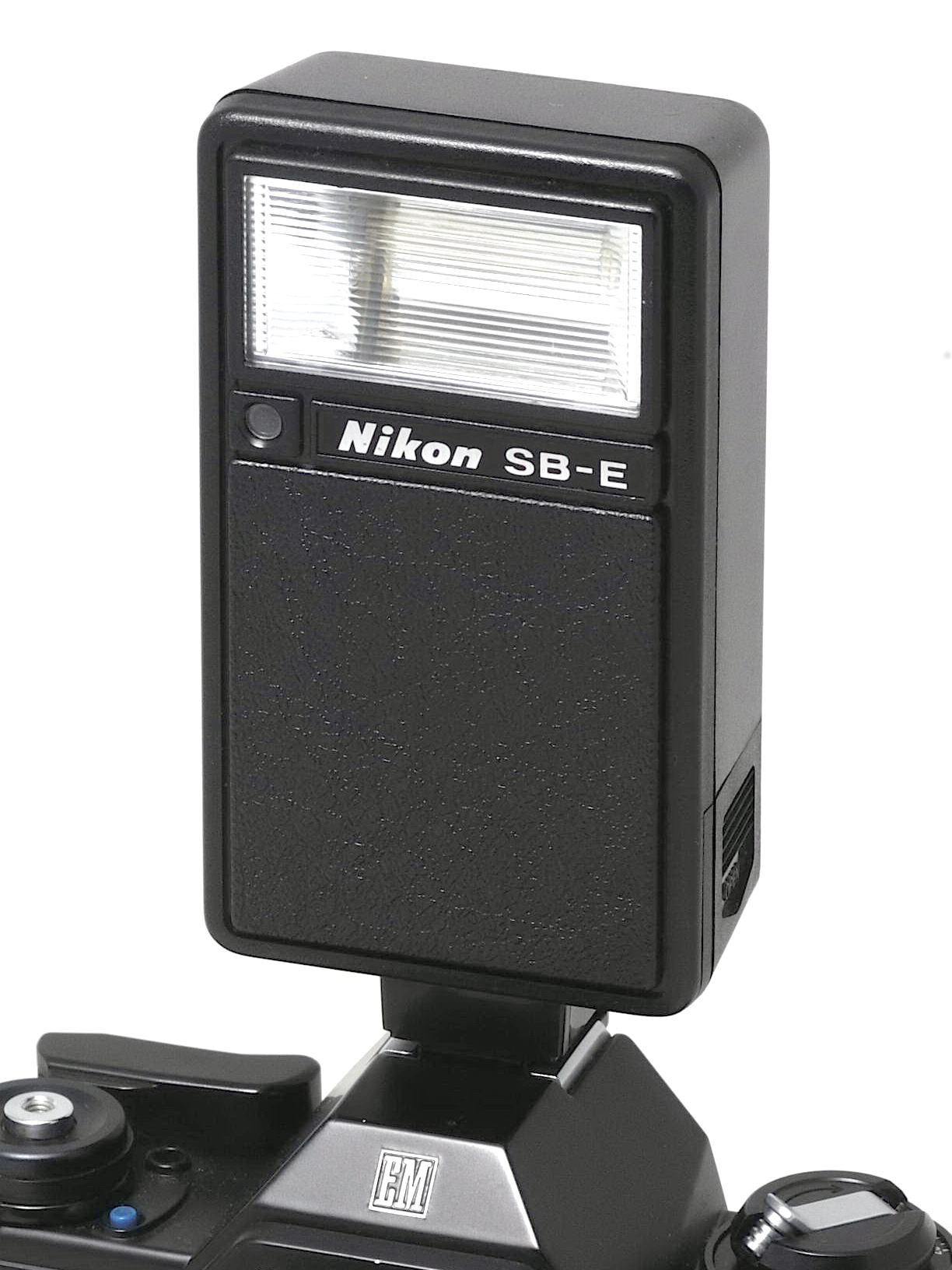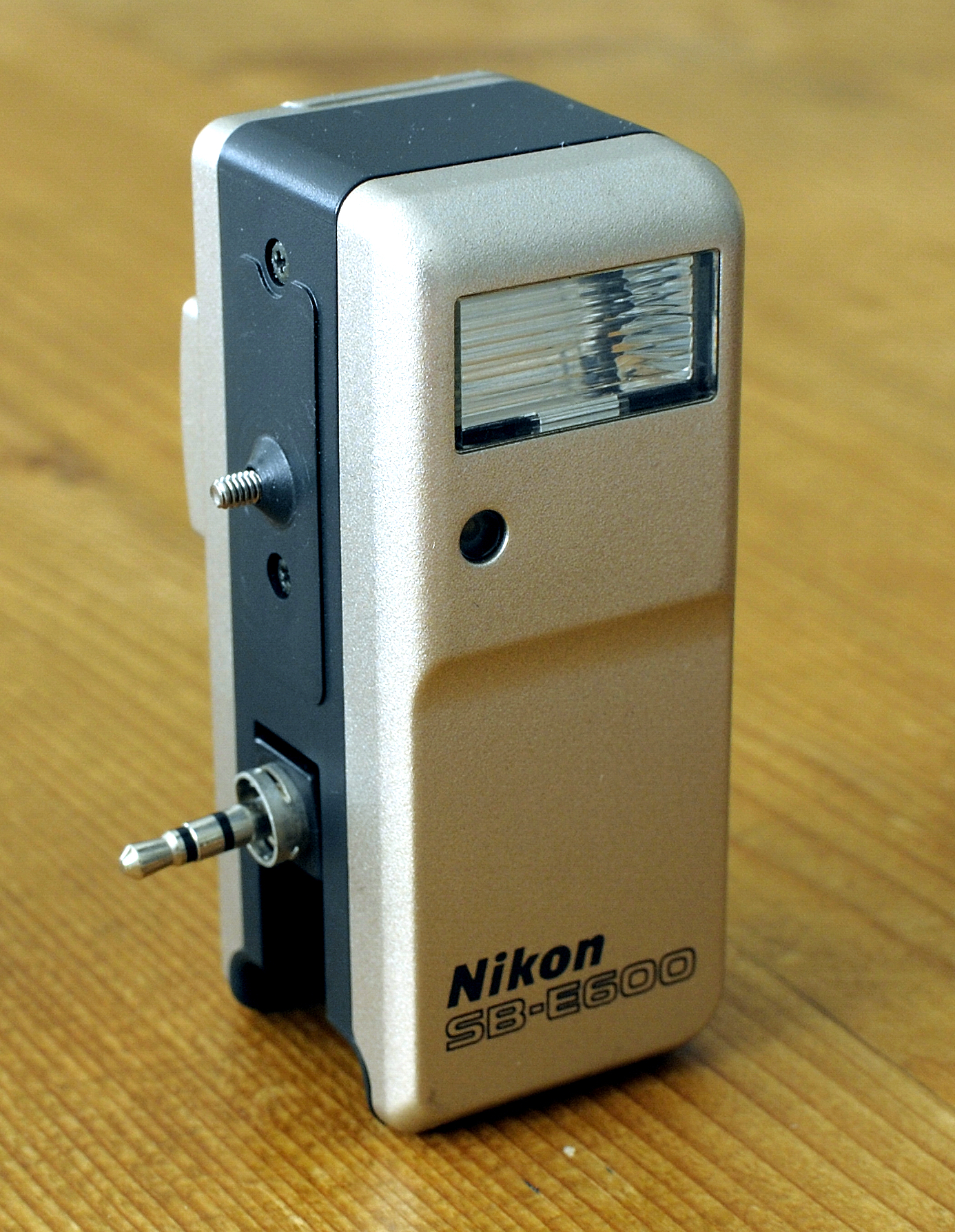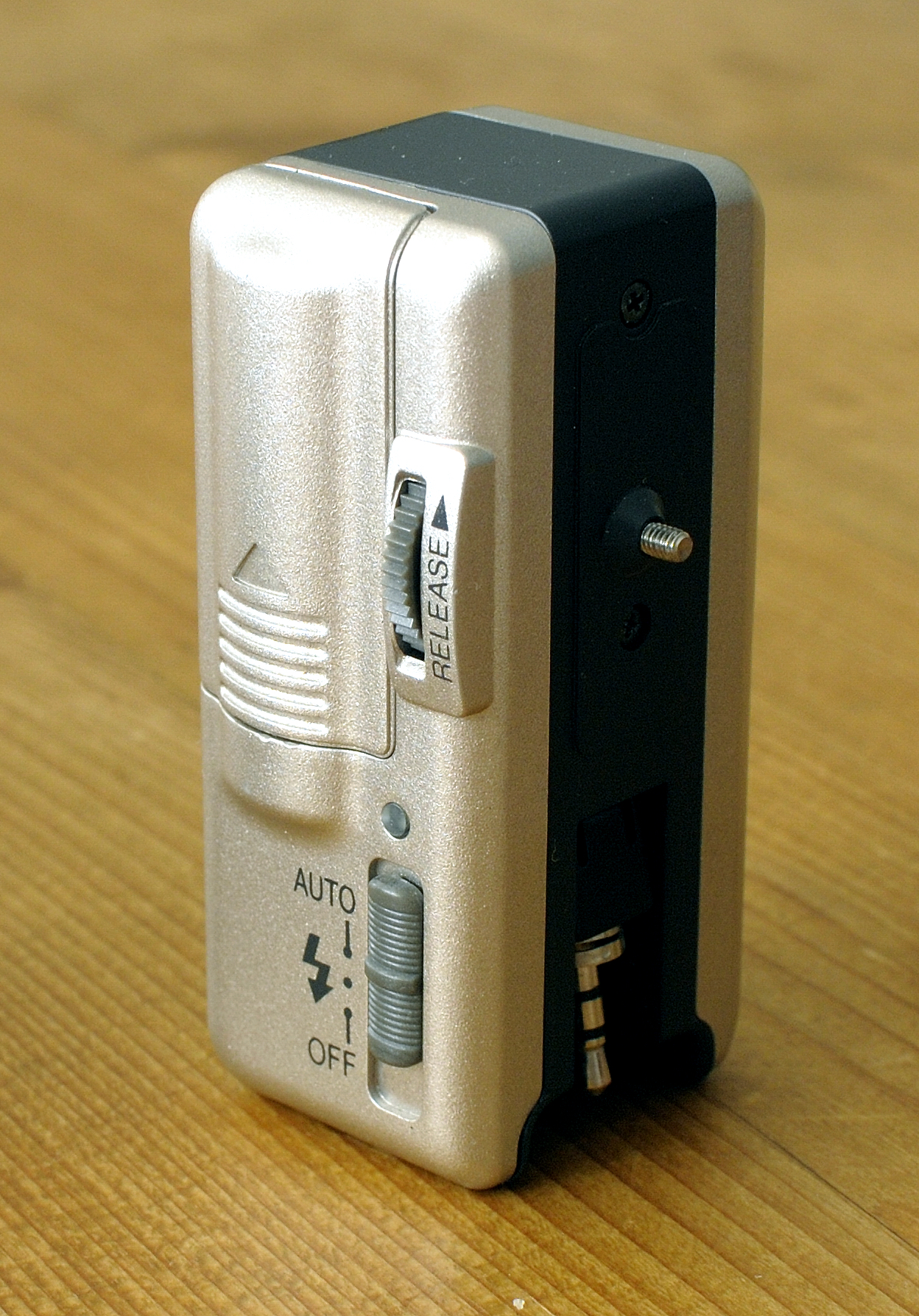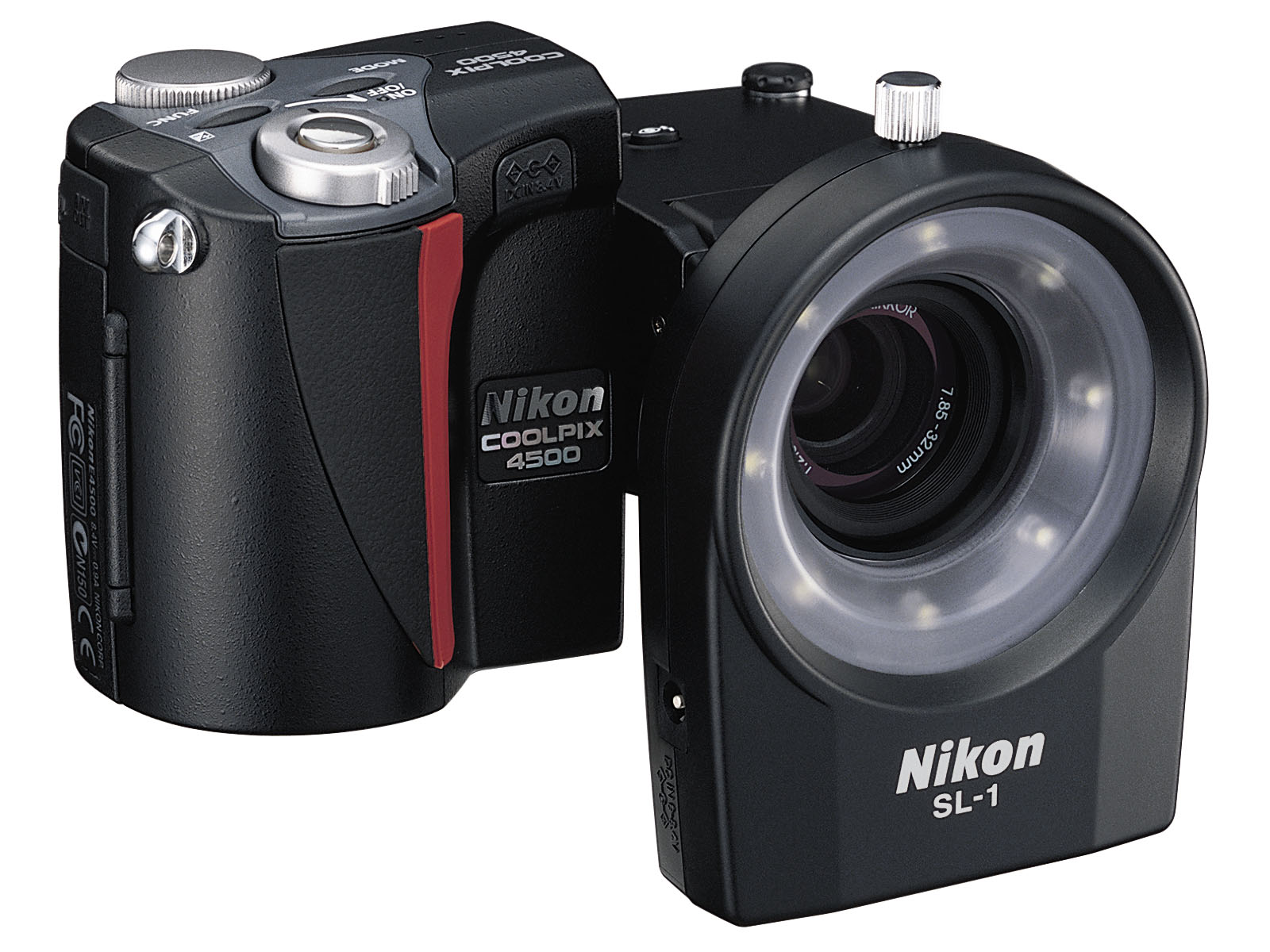Nikon flashlights
Nikon rangefinder camera with a rare flash adapter, enabling to use a flash and viewfinder together.
Introduction Since photography became a serious industry professional photographers needed artificial light to take pictures in low light or darkness. Some intelligent guys invented all kind of lamps or fires, but we had to wait until 1865 when the professional photographer W. White discovered magnesium powder. When igniting that powder one get a flash light with an average color temperature of 3700 Kelvin degrees. The German scientist J. Ostermeier build in 1929 the first flash lamp. This lamp was filled with metal wool of a magnesium-aluminum alloy, that gives a flash of approx. 4000 Kelvin degrees in a flash time of approx. 10 milliseconds. The electronic flash was invented by M. Laporte in 1935, although many scientists and publicists claim that Harold E. Edgerton (1903-1990), professor at the Massachusetts Institute of Technology is the ´father´ of the electronic flash. An electronic flash lamp is made of quartz glass or pyrex and filled with neon or krypton gas. A condenser is charged to a relative high voltage. After ignition a very short flash with a color temperature of 4000 Kelvin degrees or more will occur. A ´computer´ will ´manage´ the flash or light intensity and flash time. An adjustable window placed in front of the flash may guide the flash light up to the viewing angle of the lens in use. Modern flashes have a zoom head which moves when changing the viewing angle of the zoom lens. All D-lenses are communicating the distance of the object to the flash in order to get a right illumination of that particular object. Nikon Corporation has created various flash programs for their cameras and flashes. When buying a Nikon camera or flash read the documentation that comes with the item in order to see what automatic flash systems are available. You will be amazed!! All flashes have a so called guide number. That number is an indication of the maximum intensity of the light the flash can produce. Since the invention of the film and the flash, many unequal and therefore confusing numbers and other data have been used, like DIN (Deutsche Industrie Norm), European Scheiner (conform German astronomer J. Scheiner), American Scheiner (European Scheiner -4), Weston (conform American photographer Edward Weston ), ANSI (American National Standards Institute), ASA (American Standard Association) and ISO (International Organization for Standardization). Nowadays ISO is the most used standard, also by Nikon Corporation. Many manufacturers producing flash systems are using guide numbers at different focal lengths and film sensitivities. The higher the number the more impressive consumer perception their product may get. In comparing various flash systems be aware of the compatibility of the data. Nikon produced several flashes (calling them Speedlights), using flash lamps, for its first rangefinder and single lens reflex cameras. In July 1951 the first bulb lamp flash was presented. In February 1969 Nikon´s first electronic flash was introduced. Since then a range of very sophisticated flashes were presented. Some are even better than those made by special flash system manufacturers. Nikon has created a camera system with a reputation of its interchangeability: nearly everything it ever produced fits on nearly everything it produced! Nearly all flashes can be used on nearly all cameras. Sometimes one has to dig into the jungle of Nikon flash accessories, but in most cases your flash will fit your camera, whatever year it was produced!
Note: Nikon made very nice and sophisticated flash lights. Other manufacturers were/are trying to compete, sometimes some succeeded. A lot of them didn´t. All Nikon flashes were made for the use on Nikon cameras only, thus - only Nikon flashes will function 100% on a Nikon camera. Using flashes, cables, adapters, switches and brackets of other manufacturers may cause problems or even short circuit. Be also careful not to use too many Nikon flashes on one flash contact, either on a camera or a flash unit. Read the manual of the camera or flash unit - or - if you are uncertain use a slave-unit. Nikon made them as well. See below. Flash with glass bulb lampThe following BC models are not all build by Nikon. Some have indicators of manufacturers of electronics like Sako and Toshiba. Nikon BCB (Model 1) In July 1951, just 3 years after the introduction of the first Nikon camera, Nikon presented a bulb flash. The Nikon I and a great part of the Nikon M didn´t have a flash contact, so why should Nikon produce a flash? This flash had to be connected to the camera via a bracket and a cable. The flash is telescopic and can be extended. This flash has got the name BCB without a number . Nikon BCB Model 2) One year later, in July 1952, the second model was introduced. It is almost identical to Model 1 except for its little shorter telescopic flash arm and a different battery compartment (4 AA-batteries). There are also 4 rings in the reflector in stead of 5 as in the Model 1. Nikon BC (Model 3)
Nikon S (8-digit) with BCB3 flash (without bulb and connecting cable) In November 1954 an improved flash was presented. The reflector has no rings, it has a modern synch-connector and feels more solid. There are two versions of this model: Version 1 has the old connectors, while the second version has the ISO-connectors for use on a Nikon S2 and later cameras. The lamp in the first version has a bayonet, in the second version the lamp has a thread. That second version appeared on the market early 1955. Nikon BC-4
This little flash (see picture at the top of this chapter) with its folding reflector was introduced in October 1955. It is the first Nikon flash with removable or exchangeable lamps and it has a connector for Nikon rangefinder cameras, like the Nikon S2, S3, S3M, S4 and SP. And for several Nikon SLR cameras via a flash adapter. This flash needs 22.5 Volts batteries. Nikon BC-5 In July 1957 Nikon introduced this flash with folding reflector. It can be used with AG1, M2 and M5 flash lamps with a direct connection to the under BC-4 mentioned cameras. This flash needs 22.5 Volt batteries. Nikon BC-6 This little flash, introduced in April 1961, with a fixed reflector and cable will fit nearly all rangefinder cameras and the Nikon F via an AS-1 flash coupler. It can only be used with AG1 lamps. Also this flash needs 22.5 Volts batteries. Nikon BC-7
A very sophisticated flash with folding reflector - introduced in 1965 - that can be used on nearly all Nikon rangefinder and SLR cameras via optional flash connectors/shoes. By exchanging the socket lamps like AG1, M2, PF24 and PF45 can be used. Powered by a 15 Volt battery this flash exists as Nikon and as Nikkor version.
Electronic flashlights(listed in number order) Nikon introduced its electronic flashes as Speedlights
SB-1
Nikon F + GN-Nikkor 2.8/45 mm. + SB-1 Nikon introduced in February 1969 its first and very sophisticated and powerful electronic flash. Powered by a NC-battery this handle-mount flash weights in at 1.1 kilo! It can be used with lenses with a focal length of 35 mm. and longer on nearly all Nikon SLR cameras - fitted via the right connector. Various accessories are available, like an AC-adapter (Nikon SA-1) for use in a studio and various battery packs SD-2, SD-3 & SN-1). Its guide number is 125 (in feet) or 38 (in meters) at ISO 125. Via the SE-2 cord up to three flashes can be fired. Fitted with a SF-1 ready light mounted on a Nikon F SLR flash ready light is provided. Via the SC-4 cord ready light on several Nikon F2 models is provided. See also at SR-1 (below). SB-2 This electronic flash was introduced - together with the SB-3 - in December 1972. It has a power saving thyristor system and can be mounted on a Nikon F2 hot shoe and activates the ready light in the F2 prism. Powered by 4 AA-batteries the flash has a guide number of 80 (feet) or 25 (meters) at ISO 100. It has a built-in ´silicon-controlled rectifier´ (SCR), which measures the right amount of flash light. SB-3 This flash is basically the same flash as the SB-2, but fitted with a standard ISO foot for the use on a standard hot shoe, like those of the Nikkormat´s and later cameras. Normally both the SB-2 and SB-3 can be used with lenses with a focal length of 35 mm and longer, but fitted with the SW-1 wide-angle adapter 28mm.-lenses can be used. The SF-1 ready light and SC-4 cord (see above) are accepted by both flashes as well. SB-4 Introduced in March 1974 this flash is Nikon´s first compact flash. It has a standard ISO foot for the use on many cameras with a standard hot shoe, but it can work on e.g. Nikon F2 via the AS-1 adapter. It has a built-in PC cord for cameras that don´t have a hot shoe. Guide number (GN) is 52/16 (feet/meters) at ISO 100. This flash operates with just one single aperture setting. SB-5 This very sophisticated handle-mount electronic (thyristor) flash was introduced in September 1975. It has variable power control. One can select full power operation (GN 105/32), at 1/4 power or at MD = motor drive setting, which equals 1/8 power (GN 36/11). At MD the flash can fire up to nearly 4 fps at a burst of up to 40 frames! This flash that can be fitted with various sensors and battery packs, covers 28mm lenses and longer. With an optional SU-1 sensor automatic operation is possible.
SB-N5
This cute flash light was introduced in September 2011 with the Nikon 1 (One) series digital EVIL cameras. It has a Guide Number of 8.5 at ISO 100 in meters; so the effective range is 0.6 - 2 meters. The flash head can rotate 180° to the right and 180° to the left, vertically 90°. The flash i-TTL compatible. SB-6 In February 1976 this very specialized repeating (or stroboscope) flash, delivering up to 40 (!) flashes per second, was presented. It can be used at various power settings (full - 1/32) starting at a powerful GN 147/45. Via various AC- and DC-units and battery packs as well as different flash shoes it can be used on many cameras. SB-7 / SB-7E This compact flash - presented in June 1977 - will fit Nikon F and F2 cameras, or Nikon F3 (via AS-3) or any other camera with a hot shoe (via AS-2). GN = 82/25. This flash covers lenses from 35 mm and longer, but with the SW-2 adapter also 28mm.-lenses. The SB-7 can be used with the SA-2 AC-adapter. Hereafter many small flash lights have the same body (see SB-8E), like the SB-7, SB-8, SB-10, SB-12, SB-15 and SB-17. SB-N7 At the end of October 2012 Nikon introduced this flashlight for the Nikon 1-series. It has a GN of 18 (ISO100 + meters), has a tilted head up to 120° and uses AAA-batteries. SB-8 / SB-8E
This flash is identical to the SB-7. It has a standard foot for nearly all Nikkormats and later Nikon SLR´s. It may fit a Nikon F and F2 via an AS-1 adapter, a Nikon F3 via an AS-4 or AS-7. The SW-2 adapter can be used as well. Powered by 4 AA-batteries.
Nikon used a similar design for various compact flashlights (SB-2,-3,-7/E, -8/E, -10, -12, -15, -17 and -27). SB-9 In June 1977 Nikon introduced this mini flash; usable on nearly all cameras (SLR and compacts) with a standard hot shoe. GN = 46/14. It is powered by 2 AA-batteries. SB-10 Presented in April 1978 this flash has the same design and specifications as the SB-8. It was designed for the use on the Nikon FE. Fitted with the SW-2 it covers lenses from 28mm and longer. SB-11
This very powerful, though complex handle-mount flash was introduced in March 1980. It works - even TTL with the SU-2 sensor - on several cameras via several cords, adapters and battery packs. GN = 118/36. Many photographers didn´t like this flash due to its weight (900 gram) and its harsh light. The SU-2 sensor can be used individually as well: on the SB-14, as a slave unit and - via SC-13 cord - on any ISO shoe, although not TTL. Pictured above the SB-11 + SC-12 cord + SD-8 High Performance Battery Pack mounted on a Nikon F3 + MD-4 + MK-1 + Nikkor 1.2/55mm. A very nice reporters set, but using 22 AA-batteries (!) (8= MD-4; 6= SD-8; 8= SB-11) and weighing in at nearly 4 kilo! SB-12
This compact flash, introduced in March 1980, only works TTL on all Nikon F3 models. Its foot fits on a F3 rewind crank only! GN 82/25. When the flash is mounted on a Nikon F3 it automatically sets the shutter speed to 1/80 sec. and the flash ready light in the standard or HP-viewfinder. Exposure can be compensated by the use of the exposure compensation dial on the Nikon F3. With the SC-14 cord the flash can be used off the camera, while maintaining TTL. The AS-6 adapter allows the use of this flash (without the TTL feature) on any camera with an ISO shoe.
Nikon engineers or marketers were probably afraid of using the with mysticism surrounded number 13, so the next model is: SB-14 This handle-mount flash was presented in December 1981. GN = 105/32. It covers 35mm-lenses, with the SW-5 adapter even lenses with a focal length of 24 mm. It comes with a SU-3 sensor and can be used on many cameras via various adapters. TTL on a Nikon F3 via SC-12 and on many ISO shoe cameras via SC-23. SB-15
This little box is the basic design of the SB-2, SB-3, SB-7, SB-8, SB-10, SB-12, SB-15 (shown above) and SB-17. They do not necessarily share the same specifications nor shoes nor connectors, but they look the same. With the SB-16 Nikon introduced the upright flash body. The SB-15, introduced in April 1982, works in TTL mode with nearly all Nikon SLR fitted with a ISO shoe. GN = 82/25. The SW-6 adapter allows the use of lenses with a focal length of 28 mm. It is powered by 4 AA-batteries. Used on automatic cameras the shutter speed is selected automatically. Finally this flash has a motor drive setting as well. SB-16A - SB-16B
In April 1983 Nikon introduced this nice flash, that fits many cameras by just changing the lower module. The SB-16 + AS-8 module (= SB-16A) will work TTL with the Nikon F3. Fitted with the AS-9 module (SB-16B) it can be used on many cameras with a ISO shoe. The SB-16 has a manual zoom head, ranging from 28 - 85 mm.; fitted with a SW-7 adapter even down to 24 mm. GN = 105/32 (28mm.) - 138/42 (85mm.).
Above left Nikon SB-16B, right Nikon SB-16A Above module AS-9 for cameras with an ISO shoe (= connector) and the AS-8 for Nikon F3 cameras only.
SB-17 The ´brother´ of the SB-15, introduced in June 1983, with the same specifications will fit the Nikon F3 only. SB-18
This tiny flash was not sold separately, but mainly in a set with the Nikon FG, since October 1983. It works automatically with the FG but also with other automatic Nikon SLR´s, like the Nikon FA and Nikon FE/2. GN = 66/20. SB-19 Even a bit smaller is this compact flash, introduced in March 1984 for the use with the Nikon FG and Nikon EM. It has features identical to the SB-18. SB-20 In April 1986 Nikon introduced its first auto focus flash unit, together with the first Nikon AF-SLR 501/2020. The SB-20 has a rotating screen around the flash tube that changes the angle of light to cover 28 mm to 85 mm lenses. GN = 72/22 (28mm) - 118/36 (85mm). It is packed with features, like ´standby´, TTL, ´bounce´ and many more. Together with a great variety of adapters it will work on many cameras. The AF illuminator emits a red beam of light to help the camera to focus in dark situations. This illuminator only works on auto focus cameras when the auto focus selector switch is set to ´S´. It will not work if set on ´C´. SB-21A - SB-21B This macro speedlight, introduced in October 1986, consists of two flash tubes and focusing bulbs that attach to the front element of a lens (filter thread 52mm and 62 mm). Fitted with the AS-12 controller unit (above right) it will work in TTL with a Nikon F3. When fitted with the AS-14 (Number 13 isn´t used here either !!) it will work on any camera with an ISO flash shoe (above left). This macro flash can be powered by 4 AA-batteries or by the LD-2 battery pack of the Medical-Nikkor Unit. GN = 39/12. When using the AF-Micro-Nikkor 2.8/60mm the UR-3 adapter ring that fits the lens barrel (not the filter thread!) is required. Via various adapters and cords other flashes can be used on many cameras. If a Nikon F4 with its DW-20 or DW-21 is used a SC-24 cord is needed. SB-22 - SB-22s
The SB-22 - introduced in April 1987 - is an auto focus flash, using 4 AA-batteries, that delivers GN = 82/25. It has an auto focus illuminator and a built-in wide-angle diffuser (see photo), but no zoom flash head. In August 1998 (11 years later!) the SB-22s with a slightly higher GN was presented. Apart from the TTL features this flash works with the multi-sensor flash programs of the modern SLR´s, like the Nikon F5, F100, F90X and F70. SB-23
Again a very compact but powerful auto focus flash, introduced in March 1988. GN = 66/20. Very well usable in M-mode with modern D-SLR or Coolpix cameras with a flash hot shoe. This flash light is one of the very rare flash lights that does not give a flash ready signal in the viewfinder of any camera!. SB-24
Introduced in June 1988 together with the Nikon F-801 / N8008, Nikon astonished the world of photography with this sophisticated flash. It is packed with features, like matrix balanced flash, center-weighted fill flash, TTL, stroboscopic flash, auto focus illuminator at full darkness, zoom reflector (automatic when a CPU-lens is used) and a massive GN = 164/50. All features are possible when fitted to a Nikon F-801 or Nikon F4. Before using the SB-24 inside the battery compartment a small sliding switch can be used to set the distance scale in feet or meters! Many adapters, cords and battery packs are enabling the use of this flash in various situations, combinations on many cameras (even digital SLR´s). Many books have been written on this very popular flash. SB-25 The SB-25 - presented in October 1992 - is seen as the successor of the SB-24. It has all features of the SB-24, but many extras like fully automatic fill flash (3D multi-sensor balanced etc.), standard TTL flash, FP high-speed sync flash, rear-curtain sync flash, red-eye reduction and repeating flash. The automated zoom head has a manual override as in the SB-24 + a pull-out diffuser for the use of a 20mm. wide-angle lens. Above the diffuser a white card can be pulled out for bouncing flashes. If you buy this flash buy one of the books or manuals that have been written, too! It is impossible to give all features here. SB-26
In October 1994 Nikon introduced this upgraded version of the SB-25. The two main additional features are the 18mm pull-out diffuser and the (world´s first!) sync-adjustable photo slave flash system. Please buy one of the books, covering all features of this sophisticated flash. Competitors are still speechless about it. SB-27
This little flash, introduced in September 1995, looks a bit like the SB-15/17, but has much more to offer. It has an automatic zoom head (24-70mm), TTL, AF-illuminator, red-eye reduction, rear-curtain sync and a built-in diffuser card. GN = 112/34 (50mm) - 82/25 (24mm). SB-28 - SB-28DX
This successor of the SB-26 was introduced in November 1997. GN = 164/50. It has nearly all SB-26 features, except rear-curtain sync and wireless remote capability. In September 1999 the DX-version was introduced. This flash has a built-in sensor to measure the reflected light in the various programs. When a modern flash is fitted on a camera, using a film, the bounced flash light will reflect on the film plane when the shutter is open. On basis of this reflected light the flash and camera computer are determining the flash sync and intensity. A digital sensor in a digital reflex camera doesn´t reflect properly flash light; that´s why a DX-flash should be used as these flashes do have an extra flash intensity measuring sensor. SB-29 - SB-29s
This look-alike of the SB-21 was introduced in September 1999. The SB-29s, featuring additional manual settings, was introduced in June 2002. Both models have two flash tubes, an AF-illuminator, built-in diffuser and adapters to fit at lenses with a filter thread of 52mm, 62mm and 72mm. GN = 38/11. SB-30
This mini-flash was introduced in April 2002. Although it has a GN = 52/16, it features built-in infrared filter, wide-angle adapter, macro-setting and a wireless TTL slave unit! This flash doesn´t work with Nikon´s i-TTL program. SB-50DX
In August 2001 Nikon introduced this little flash for the use on Coolpix and digital reflex cameras with a built-in flash. If fitted on a camera with built-in flash its flash can be fired simultaneously or the white diffuser can be folded over the flash of the camera. It features various flash programs, like 3D-fill flash and has a built-in diffuser for the use of 14 mm lenses and a wireless slave unit. SB-80DX
This powerful flash (GN = 120/38), specially made for digital photography was introduced in June 2002. It is packed with various flash programs and has a wireless TTL slave unit. If needed 4 SB-80DX flashes can be used in TTL mode simultaneously without cables or cords. SB-140 infrared In December 1985 Nikon introduced this upgraded version of the SB-14. The SB-140 is for ultraviolet, visible and infrared photography. It works TTL (visible light only) with a Nikon F3 via a SC-12 cord or with other cameras via the SC-23 cord. Over the flash head three special filters can be placed: the SW-5V for visible light at 400-100nm, the SW-5UV for UV light at 300-400 nm and the SW-5IR for infrared light at 750-1100 nm. GN = 32/10 (SW-5V), 22/7 (SW-5IR) and 16/5 (SW-5UV). The SB-140 is powered by the SD-7 battery pack.
SB-300
This surprisingly small and easy to use flash light was introduced early August 2013. It can be used by all FX and DX digital reflex cameras as well as those Coolpix cameras that support i-TTL. Its guide number is 18m/59ft (ISO 100) and its weight is less than 100 gram. The flash can be rotated vertically 120° and has almost no buttons and screens on its back (see photo). The FV (flash volume) lock function, with which flash volume is determined based on monitor flashes and saved so that composition may be changed while maintaining the flash value, is not supported by the Nikon D5200, D5100, D5000, D3200, D3100, D3000, D60, or D40-series cameras; among COOLPIX cameras, only supported by the COOLPIX A. The flash uses AAA-batteries.
SB-400
This cute little flash light (less than 130 gr.), introduced together with the Nikon D-40 in November 2006, will fit most modern cameras. It has a GN of 30 and will cover an angle of an 18 mm. lens. The little flash head can be lifted up to 90 degrees. This speedlight uses 2 x AA batteries. Note: SB-400 cannot be used with cameras not compatible with Nikon Creative Lighting System.SB-400 is not compatible with Advanced Wireless Lighting.
SB-500 Mid-September 2014 Nikon introduced a compact flashgun, usable on all digital reflex cameras except the Nikon D1-series and Nikon D100. The flash can be used on the Nikon F6 and those Coolpix cameras that are compatible with CLS and i-TTL flash programs, too. The flash head tilts 90° and rotates horizontally 180°. Guide number is 24 at ISO 100 in meters. The flash 'eats' 2 x alkaline or rechargeable Ni-MH AA-size batteries. Its weight is 275 gram.
SB-600
This in June 2004 presented flash is made for all digital and analog cameras. It has many features, like i-TTL, wireless slave function, zoom reflector and many more. Many interesting books are available for this sophisticated flash, that was introduced as part of Nikon´s Creative Lighting System. SB-700 Mid September 2010 Nikon introduced - as part of Nikon's Creative Lighting System - this sophisticated flashlight. It has wireless flash control, i-TTL, built-in slave unit, a head which can be bounced 90° up and 7° plus a 360° rotation. SB-800
This successor of the SB-80 was introduced in November 2003. GN = 120/38 at 35mm. It has all SB-80 features plus an automatic white-balance-setting when used on the Nikon D2 and D3 series and an improved i-TTL management. The zoom head has a range of 24 - 105 mm. For extra power a SD-800 battery pack can be attached to the side of the flash. Note: In most Nikon camera manuals the Nikon SB-800 is hushed up for whatever reason! The SB-700 and e.g. the SB-900 are mentioned but not the SB-800 !! SB-900 As the successor of the SB-800 this unique flash was introduced in July 2008. It has nearly all features of the SB-800 + certain novelties. This flash is the world´s first flash that can accept software upgrades when mounted on a Nikon D3 or Nikon D700 camera! The zoom head can cover the focal length of lenses from 17 up to 200 mm.! Its sensor can work together with the new CAM3500 sensors in the latest digital reflex cameras. GN = 157/48 (at ISO 200). This modern flash, powered by 4 AA-batteries, has an i-TTL slave function, making it possible to work with several flashes at the same time. In November 2008 Nikon issued a firmware upgrade (5.02) for both Macintosh and Windows. Ask your dealer or contact your local Nikon representation. When buying a second hand flashlight check the firmware! SB-910
Late November 2011 Nikon introduced this successor of the SB-900. It has a guide number of 112/34 (at ISO 100) and a refined user interface via a new MENU button. It also features three illumination patterns (standard, even and center-weighted), automatic detection of hard color filters attached to the front of the flash head and automatic detection of FX- or DX-format. The zoom-head covers focal lengths of lenses offering 17-200 mm. (14 mm with wide-panel) in FX-format and 12-200mm. (10 mm. with wide-panel) in DX-format. Other features are identical to those offered by the SB-900.
SB-5000 |
